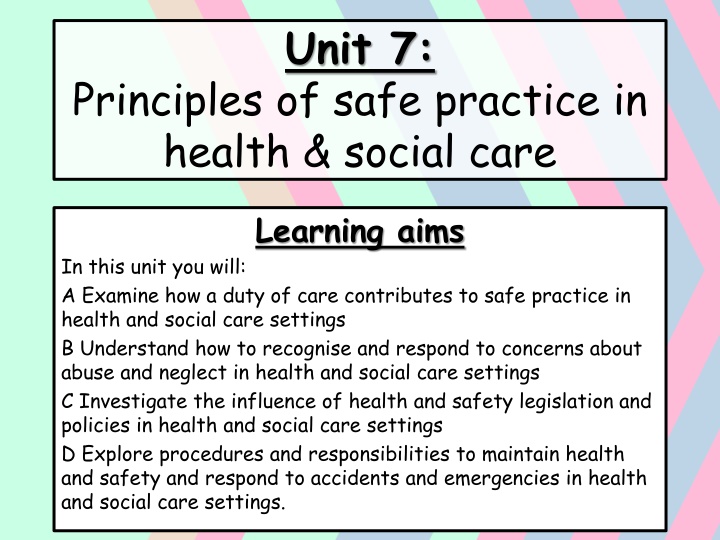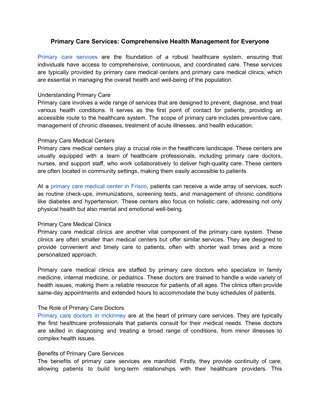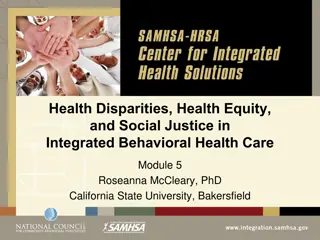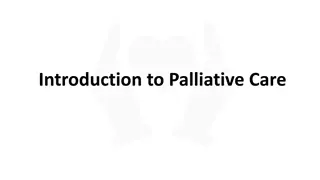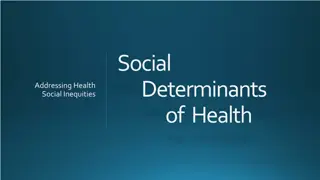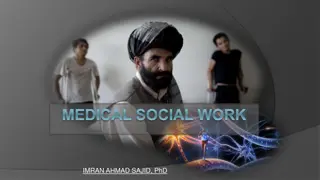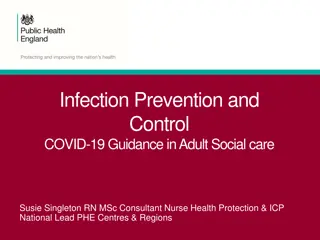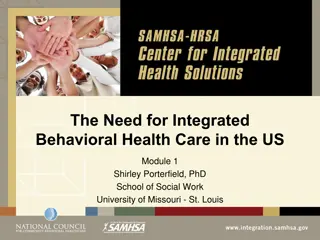Principles of Safe Practice in Health & Social Care
Learners in health and social care settings explore duty of care, abuse recognition, health and safety legislation, and emergency response procedures. The unit emphasizes maintaining safe working practices, safeguarding vulnerable individuals, and handling emergencies effectively. Understanding the legal duty of care, recognizing abuse and neglect signs, and responding appropriately are key components covered in this unit. Practical procedures for maintaining safety and responding to accidents are also addressed.
Download Presentation

Please find below an Image/Link to download the presentation.
The content on the website is provided AS IS for your information and personal use only. It may not be sold, licensed, or shared on other websites without obtaining consent from the author.If you encounter any issues during the download, it is possible that the publisher has removed the file from their server.
You are allowed to download the files provided on this website for personal or commercial use, subject to the condition that they are used lawfully. All files are the property of their respective owners.
The content on the website is provided AS IS for your information and personal use only. It may not be sold, licensed, or shared on other websites without obtaining consent from the author.
E N D
Presentation Transcript
Unit 7: Principles of safe practice in health & social care Learning aims In this unit you will: A Examine how a duty of care contributes to safe practice in health and social care settings B Understand how to recognise and respond to concerns about abuse and neglect in health and social care settings C Investigate the influence of health and safety legislation and policies in health and social care settings D Explore procedures and responsibilities to maintain health and safety and respond to accidents and emergencies in health and social care settings.
Unit in brief Learners explore the importance of safe working practices, safeguarding procedures and responding to emergency situations in health and social care settings. Unit introduction When working in health and social care settings, you must have a clear understanding of the duty of care and safe working practices and procedures, and how to promote the safety and wellbeing of service users. Safe working practice is a priority in health and social care. This unit will develop your knowledge and understanding of the key principles relating to safeguarding vulnerable individuals, promoting health and safety, and responding to different situations and emergency incidents in health and social care settings. You will learn about the professional responsibilities for maintaining safe practice. You will explore the legal duty of care and the importance of legislation, policies and procedures in protecting individuals from harm, upholding their rights and promoting their welfare. You will examine the types of abuse and neglect that service users can experience and learn how to recognise and respond to concerns about abuse and neglect in health and social care settings. This unit will support you in carrying out practical procedures to maintain health and safety and respond to accidents and emergencies in health and social care settings, such as infection control procedures and fire and evacuation drills.
Learning Aim A: Examine how a duty of care contributes to safe practice in health and social care settings. P1: Explain the implications of a duty of care in a selected health or social care setting. Assess the importance of balancing individual rights with a duty of care in a selected health or social care setting. appeals procedures address failure in a duty of care in a selected health or social care setting. Learning Aim B: Understand how to recognise and respond to concerns about abuse and neglect in health social care settings P3: Describe the types and signs of abuse and neglect that may be experienced by different individuals. P4: Explain the likelihood of abuse and neglect for service users in health and social care. D1: Evaluate the significance of a duty of care and complaints procedures in promoting safe practice in a selected health or social care setting. M1: P2: Discuss ways in which complaints and D2: M2: Justify procedures for responding to concerns about abuse and neglect in the selected health or social care setting. Assess the importance of recognising and responding to evidence or concerns about different types of abuse and neglect in health and social care P5: Explain how to respond to concerns about abuse and neglect in the selected health or social care setting.
Learning Aim C: Investigate the influence of health and safety legislation and policies in health and social care settings. P6: Compare the influence of different health and safety laws or polices on health and social care practice in a selected setting. abuse and neglect in health and social care. M3: D3: Assess the importance of recognising and responding to evidence or concerns about different types of Justify the effectiveness of health and safety legislation, policies and procedures in maintaining health and safety in a selected health or social care setting. Learning Aim D: Explore procedures and responsibilities to maintain health and safety and respond to accidents and emergencies in health and social care settings. P7: Explain how different procedures maintain health and safety in a selected health or social care setting. M4: D4: Analyse how individual responsibilities and health, safety and emergency procedures contribute to safe practice in a selected health and social care setting Evaluate the importance of safe practice principles in maintaining and promoting the health, safety and welfare of service users in a selected health or social care setting. P8: Explain the health and safety responsibilities of employers, employees and others in a selected health or social care setting.
Date: Sunday, 02 March 2025 Lesson Title: What is a duty of care? Lesson Outcome: Explain the implications of a duty of care in a selected health or social care setting. (P1)
Working in health and social care means you must consider the public s confidence in your ability to safeguard the welfare and the best interests of service users. A duty of care is a responsibility to behave in a way that promotes welfare and does not cause harm, and applies to all health and social care workers. You will owe a duty of care to many people including service users, colleagues, your employer, yourself, visitors, family and friends of service users and also the public interest - this means anyone likely to observe or be affected by your actions.
The Green Care Home in Leeds try to ensure all their residents are safeguarded. As you watch the video clip note down all of the different ways that they do this.
Mrs Shah was a regular member of the community choir in her village. Since the death of her husband, she had lived in a local care residence, but kept in contact with her friends and really enjoyed attending the choir practice at the village hall. Mrs Shah had arthritis and needed support to walk the short distance to the village hall. One of the care staff at the residence, who was also a choir member, went with her to ensure her safety. After one practice, Mrs Shah decided to have coffee at a cafe which was near the village hall. She opened her handbag to take out her purse and found that it was missing. Mrs Shah became upset and started to shout that her purse had been stolen. The member of staff told her to calm down and produced the purse from her own handbag. The care worker had decided that Mrs Shah was becoming forgetful and might lose her purse. She had removed the purse when she had collected the handbag from the residence day room where Mrs Shah had left it. a) Are the care worker s actions an example of safeguarding? What action should the care worker have taken? How could this incident have affected Mrs Shah? b) c)
Legal obligation to protect wellbeing and prevent harm Duty of care is defined simply as legal obligation to always act in the best interests of the service user and any others that may be affected by your actions. You should not act, or fail to act, in a way that results in harm. You should know the limits and act within your competence level. Part of your code of professional conduct is to set relationship boundaries. It is important to understand that a professional relationship has boundaries. It is very different to your relationships with family and friends. professional detachment means that you can provide care objectively and without becoming emotionally involved. SAFETY TIP: You should not take on tasks that you do not think you perform safely.
Upholding the rights and promoting the interests of individuals experiencing abuse or neglect All service users have rights. However, they may not feel able to ask for what they need because they are scared of physically intimidated by another service user, a member of their own family, a friend or even a member of staff. All service users are individuals with unique needs and abilities. Some service users may lack the capacity to protect their rights because they do not have the mental capacity to understand the implications of their circumstances. You should always consider how disrespectful remarks or actions may impact on the service user s self-esteem. You must work on the principles that the service user is telling the truth- it is not your job to judge them or tell them that they are wrong. SAFETY TIP: Never promise to keep a secret for a service user as this may put you and the service user at risk of harm. Always tell the service user that you will not keep a secret and make sure that you follow the disclosure policy of the organisation you are working for.
Protecting health, safety and wellbeing. In the workplace, you are in a position of trust in relation to all service users. It is important to understand that a service user may be vulnerable and you have to take responsibility for the unequal distribution of power, so that the service user is not exploited, intimidated or unjustly treated. When you are working with service users, you should be able to explain to your managers how your actions were safe, fair and considered, and proportionate or warranted. You have a duty as an employee to take care of them as well.
Ensuring safe practice. Whatever care setting you work in, including a service user s home, you must ensure that you follow and put into practice the safe workplace policies set by your employing organisation. The Care Quality Commission (CQC) requires that health and safety training should be part of your induction to the care workplace. Training is an important part of safe and effective working practice and you should ensure that you attend your training sessions to learn about this important aspect of your working life. SAFETY TIP: Remember that the floor should be as clear as possible. Pets, such as cats and dogs, can prove to be hazards. Pets should be moved to a different room before you perform any task involving large equipment, such as hoists or wheelchairs, or if your service user needs assistance to walk.
Code of conduct A code of conduct is a framework to work to. It tells you how to behave when interacting with others, maintain and improve the quality of your service, be effective in what you do, stay safe and promote the safety of others. The code of conduct sets the standards for your profession. It gives people an idea of what to expect and an indication of how to tell when things do not meet these standards, or when things can be improved.
Balancing individual rights with risks. We live in a complex, multi-cultural society in which needs, rights and associate risks may be interpreted very differently. We do not live in isolation, so one person s choices usually have an effect on other individuals, whether positively or negatively. Healthcare professionals may have power over those in their care that service users find difficult to challenge. Many service users fear losing their independence, which can cause conflict with healthcare professionals and friends and family, who may feel that the service user will not cope with independent living. Additionally service users have the right to accept to reject any course of treatment or care that is offered to them. Before examining duty of care and the policies and procedures involved, it may be helpful for you to think about the service user as an individual. Service users have the right to make informed choices even if those choices may involvement a small amount of risk. SAFETY TIP: Different care settings have different policies and procedures, depending on the needs of the service users. Always familiarise yourself with the policies and procedures of the organisation that you are working for before you start to deliver care.
Acting in a persons best interests When working in care, you may be concerned about the choices that some service users are making. You may think that the choices that you make in a particular situation would be better. You may think that you are acting in a person s best interests by preventing them from doing something. You can only do this if you have their consent unless you have evidence that the person lacks the capacity to make that particular decision at the time it needs to be made.
Case Study 1- Call me Joe To what extent does Joe seem able to carry out his personal care and domestic routines? What do we know about Joe s social systems and relationships? Is personalised care being provided? To what extent do you think Joe has choice and control over his environment? What are your thoughts about the staff and culture here? What are your thoughts about delegation and supervision here? What are your thoughts about leadership, management and team working? Do you think there is a relationship between levels of independence and vulnerability? What are your thoughts about the links to safeguarding and dignity? How do you seek the views of people in your care? How do you support individuals to exercise choice and control?
Case Study 2- 28 Weeks Why is careful record keeping and documentation crucial in this scenario? How can you empower a woman in this scenario? How can you enquire effectively about domestic abuse? How can you encourage and support the disclosure of domestic abuse? How would you respond to a disclosure of domestic abuse? Would you know what to do if a woman tells you they are experiencing domestic abuse? What sources of support or resources are available for women and health professionals? Who else should be informed that a woman is experiencing domestic abuse? What are your thoughts about domestic abuse and safeguarding children? How would you communicate with women who have difficulty reading or speaking English?
Case Study 3- Doing our best What questions should you be asking about this case study?
P1 Task. Word Document: A Duty of care is It is important because All care workers must follow 7 aspects that are to ensure that they are caring for all service users proficiently. Case Study 1- Call me Joe. In Joe s case it could be viewed as a case of neglect because The care workers have a legal obligation to protect wellbeing and prevent harm, they could do this by Care workers also have a legal obligation to uphold the rights and promote the interests of individuals experiencing abuse or neglect, Joe is experiencing neglect because to prevent this from escalating care workers may want to You should make reference to at least 3 of the aspects of duty of care. You should be explaining how it is not being met, and explain how this could be changed in the best interest of the service user. Case Study 2- 28 weeks. Case Study 3- Doing our best.
